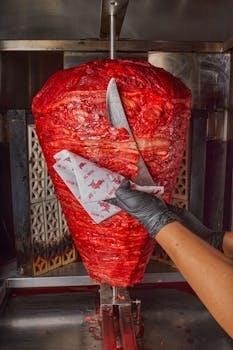The Course Projection Guide is a vital tool assisting students, departments, and administrators in planning academic offerings․ It provides insights into future course availability, enabling informed decision-making for educational and resource planning․

1․1 Definition and Purpose
The Course Projection Guide is a comprehensive tool designed to help students, departments, and administrators plan academic offerings effectively․ It defines the purpose of projecting course availability, ensuring alignment with academic goals and resource allocation․ By outlining expected course offerings over multiple academic years, the guide enables students to make informed decisions about their educational paths․ It also assists departments in scheduling courses based on demand and faculty availability, ensuring efficient resource utilization․ The primary purpose is to enhance academic planning, streamline decision-making, and support institutional strategic objectives․
1․2 Importance for Academic Planning
The Course Projection Guide plays a crucial role in academic planning by providing students, faculty, and administrators with essential insights․ It helps students make informed decisions about course selection, ensuring they stay on track to meet graduation requirements․ For departments, it aids in aligning course offerings with student demand and faculty availability, optimizing resource allocation․ Administrators benefit by using the guide to anticipate enrollment trends, plan budgets, and allocate resources effectively․ This tool ensures seamless academic progression, reduces scheduling conflicts, and supports strategic decision-making at all levels, fostering a well-organized academic environment․

Understanding Course Projections
Course projections provide insights into future course offerings, helping students, departments, and administrators plan academic paths effectively․ They ensure alignment with educational goals and resource availability․
2․1 What Are Course Projections?
Course projections are forecasts of future course offerings, helping students, departments, and administrators plan academic paths effectively․ They provide insights into which courses are likely to be available over the next few years, based on historical enrollment trends, student demand, and resource availability․ These projections are essential for ensuring that students can progress toward their degrees without delays and that departments can allocate resources efficiently․ By analyzing past data and current trends, course projections enable informed decision-making, supporting both academic and institutional goals․ They are a critical tool for aligning course offerings with student needs and institutional priorities․
2․2 How Projections Are Determined
Course projections are determined through a combination of data analysis and strategic planning․ Historical enrollment trends, student demand, and faculty availability are key factors․ Departments analyze past course enrollment data to identify patterns and predict future demand․ Additionally, student feedback, academic requirements, and resource availability are considered․ Projections are often refined through consultations between faculty, advisors, and administrators to ensure alignment with institutional goals․ This collaborative process helps create accurate and realistic forecasts, enabling effective academic and resource planning․ Regular updates ensure projections remain relevant and responsive to changing needs and priorities․
2․3 Role of Student Demand and Trends
Student demand and trends play a crucial role in shaping course projections․ By analyzing enrollment data and student feedback, institutions identify popular courses and emerging academic interests․ Trends in student preferences, such as increased demand for online or specialized programs, influence projection accuracy․ Historical data helps predict future demand, while shifts in student interests guide departments in offering relevant courses․ This ensures that academic offerings align with student needs, fostering engagement and enrollment․ Projections also consider broader educational trends, enabling institutions to adapt and remain responsive to changing student priorities and market demands․ This dynamic approach supports strategic planning and resource allocation․

Using the Course Projection Guide
The Course Projection Guide helps students, departments, and administrators plan academic paths by providing insights into future course offerings, enabling informed decisions for education and resource management․
3․1 Navigating the Guide
Navigating the Course Projection Guide is straightforward, with a user-friendly interface designed to help students and staff access essential information․ Users can search for specific courses, view projected offerings by department, and filter results by academic year or term․ The guide typically includes features like course codes, descriptions, and availability status․ It also provides tools for comparing course schedules and planning academic pathways․ Students are encouraged to consult academic advisors to align their course selections with degree requirements․ Regular updates ensure the guide reflects the most current course offerings and academic planning resources․
3․2 Key Features and Tools
The Course Projection Guide offers several key features to enhance academic planning․ It includes interactive dashboards for visualizing course availability, search filters to narrow down offerings by department or term, and multi-year projections to plan ahead․ The guide also provides tools for comparing course schedules and tracking enrollment trends․ Additionally, it integrates with academic systems like Coursedog’s Course Demand Projection (CDP) module, which analyzes student demand to optimize course offerings․ These tools empower users to make informed decisions, ensuring alignment with academic goals and resource availability․ Regular updates and user-friendly navigation further enhance its utility for students, faculty, and administrators․

3․3 How to Interpret Projection Data
Interpreting projection data involves analyzing course availability, demand trends, and resource allocations․ Users should review color-coded ratings indicating high, medium, or low demand, as well as historical enrollment numbers․ Projections often highlight anticipated course offerings, helping students plan their schedules․ Faculty and administrators can identify popular courses needing additional sections or resources․ Tools like Coursedog’s Course Demand Projection (CDP) provide insights into student preferences, enabling data-driven decisions․ By understanding these projections, users can align academic goals with available offerings, ensuring efficient resource utilization and informed planning for future terms․
Benefits of Course Projections
The Course Projection Guide offers benefits for students, departments, and administrators by enhancing academic planning, optimizing resource allocation, and supporting informed decision-making for future terms․

4․1 For Students
The Course Projection Guide empowers students to plan their academic journey effectively․ By projecting course availability, it helps students make informed decisions about their class selections, ensuring they can meet graduation requirements on time․ This tool allows students to explore their interests, avoid unnecessary delays, and align their course choices with career goals․ It also assists in balancing workload and avoiding overloading, ensuring a smooth path to degree completion․ With the guide, students can confidently map out their academic future, making the most of their educational experience․
4․2 For Departments and Faculty
The Course Projection Guide is an essential resource for departments and faculty, enabling them to plan and manage academic offerings effectively․ It provides insights into student demand, helping departments anticipate which courses will be most popular․ This allows for better resource allocation, ensuring adequate staffing and classroom space․ Faculty can use the guide to align course offerings with departmental goals and strategic priorities․ By projecting enrollments, departments can avoid overloading faculty with excessive teaching responsibilities and ensure a balanced workload across semesters․ This tool supports informed decision-making, fostering efficient academic planning and resource management․
4․3 For Administrators
The Course Projection Guide serves as a critical tool for administrators, enabling strategic planning and resource allocation․ By analyzing projected course demand, administrators can make informed decisions about hiring, budgeting, and facility usage․ The guide helps identify trends in student interest, allowing for the alignment of course offerings with institutional goals․ It also supports long-term planning, such as predicting faculty needs and optimizing resource distribution․ Administrators can use the guide to ensure efficient academic operations, avoid resource overlaps, and maintain a balanced academic portfolio that meets student and institutional demands effectively․
Course Projection Methods
Course projections rely on data analysis techniques, historical enrollment trends, and faculty availability to forecast future course offerings accurately, ensuring alignment with student demand and institutional resources․
5․1 Data Analysis Techniques
Data analysis techniques are central to accurate course projections, utilizing tools like Coursedog’s Course Demand Projection (CDP) module․ Predictive analytics and machine learning algorithms analyze historical enrollment trends, student demand, and program requirements to forecast course needs․ These methods ensure projections align with institutional goals and resource availability․ By integrating real-time data, such as student interest and faculty capacity, these techniques provide actionable insights for academic planning․ They also enable scenario planning, helping institutions adapt to changing demands and optimize course offerings effectively․
5․2 Historical Enrollment Trends
Historical enrollment trends are a cornerstone of course projections, providing insights into past student demand and course popularity․ By analyzing enrollment data over multiple academic years, institutions can identify patterns and predict future demand․ Tools like the Course Projection Guide (CPG) and department-specific spreadsheets track these trends, offering a clear view of which courses consistently attract students․ This data helps avoid over- or under-enrollment and ensures resources are allocated efficiently․ Updated annually, these projections guide departmental planning, faculty hiring, and curriculum development, ensuring alignment with student needs and institutional goals․
5․3 Faculty and Resource Availability
Faculty and resource availability are critical factors in course projections, ensuring that departments can meet student demand without overextending resources․ The Course Projection Guide (CPG) helps institutions align course offerings with faculty expertise and workload capacity․ By analyzing historical enrollment trends and faculty availability, departments can plan courses effectively, avoiding resource shortages․ Tools like Coursedog’s Course Demand Projection (CDP) module provide insights to match resource allocation with student needs․ This ensures that courses are offered in a way that supports both academic goals and operational efficiency, preventing over-allocation of resources and ensuring a balanced academic schedule․
Tools and Software for Course Projections
Tools like Coursedog’s Course Demand Projection (CDP) and other software solutions enable accurate course planning by analyzing student demand and resource availability, ensuring efficient academic scheduling․
6․1 Coursedog Course Demand Projection (CDP)
Coursedog’s Course Demand Projection (CDP) is a powerful tool designed to analyze student demand and forecast course enrollments․ It integrates seamlessly with academic scheduling systems, providing actionable insights for departments and administrators․ By leveraging historical data and current trends, CDP helps institutions anticipate which courses will be in demand, ensuring optimal resource allocation․ The module offers detailed recommendations, enabling universities to align course offerings with student needs and faculty availability․ This innovative solution streamlines academic planning, reducing the guesswork in scheduling and enhancing the overall efficiency of course management․
6․2 Other Software Solutions
Beyond Coursedog, various software solutions support course projections, such as MadMapper for projection mapping and academic planning tools․ These platforms offer tailored features like enrollment trend analysis, resource allocation, and curriculum mapping․ They often integrate with existing academic systems, providing a holistic view of course demand and scheduling needs․ Some tools specialize in visualization, enabling users to map course offerings over multiple terms․ These solutions cater to diverse institutional requirements, ensuring flexibility and adaptability in academic planning․ By leveraging these technologies, universities can optimize course availability and align offerings with student and faculty needs effectively․
6․3 Best Practices for Using Tools
Effective use of course projection tools requires regular data updates and alignment with institutional goals․ Training users ensures accurate interpretations and informed decision-making․ Monitoring trends and adjusting projections based on feedback enhances reliability․ Integrating tools with existing systems streamlines planning and resource allocation․ Regular audits and updates maintain data accuracy, while clear communication ensures alignment with departmental and administrative objectives․ By following these practices, institutions can maximize the benefits of course projection tools, fostering efficient academic planning and resource management․ Consistency and adaptability are key to leveraging these tools effectively for long-term success․
Challenges in Course Projections
Uncertainty in student demand, resource limitations, and balancing departmental needs are key challenges․ These factors complicate accurate planning, requiring adaptive strategies to ensure efficient resource allocation and course availability․
7․1 Uncertainty in Student Demand
Uncertainty in student demand is a significant challenge in course projections․ Factors like changing student preferences, economic trends, and unexpected shifts in academic interests can alter enrollment patterns․ While tools like the Course Projection Guide and Coursedog’s Course Demand Projection (CDP) module provide data-driven insights, they cannot fully predict unpredictable student behavior․ This uncertainty complicates planning, as departments must balance offering diverse courses with avoiding under-enrollment or over-enrollment․ Adaptive strategies, such as flexible scheduling and real-time adjustments, are essential to mitigate these risks and ensure alignment with student needs and institutional resources․
7․2 Resource Limitations
Resource limitations pose a critical challenge in course projections, impacting the ability to meet student demand․ Constraints such as faculty availability, classroom capacity, and budget restrictions often limit the number of courses that can be offered․ Even with accurate demand projections, institutions may struggle to allocate sufficient resources to satisfy student needs․ This can lead to tough decisions about which courses to prioritize, potentially affecting student progress and program viability․ Effective resource planning and allocation are essential to balance these constraints while ensuring access to essential courses for students․
7․3 Balancing Departmental Needs
Balancing departmental needs is a complex aspect of course projections, as different departments often have competing demands for resources and course offerings․ The Course Projection Guide helps address this by providing a centralized view of course demand and availability․ By analyzing historical data and student demand, departments can prioritize offerings while ensuring equitable resource distribution․ Tools like Coursedog’s Course Demand Projection (CDP) module offer insights to align course planning with institutional goals․ Effective communication and collaboration between departments and administrators are crucial to maintain a balanced academic schedule that meets diverse needs while optimizing resource utilization․

Practical Applications of Course Projections
Course projections enable effective academic advising, inform curriculum development, and assist in budgeting by aligning course offerings with student demand and institutional resources․
8․1 Academic Advising
Course projections play a crucial role in academic advising, enabling students and advisors to plan effectively․ By projecting course availability, the guide helps students select classes that align with their academic goals and ensure timely graduation․ Advisors can use this tool to guide students in choosing relevant courses, avoiding unnecessary delays, and meeting degree requirements․ This resource also helps students explore electives and specializations, ensuring a well-rounded education․ Projections empower advisors to provide informed recommendations, fostering student success and satisfaction․ Regular updates ensure accuracy, making it an indispensable tool for both students and academic counselors․
8․2 Curriculum Development
Course projections significantly influence curriculum development by providing insights into future course offerings․ This tool helps departments identify trends in student demand, enabling them to update and refine academic programs․ By analyzing projection data, faculty can develop new courses or modify existing ones to meet evolving student needs and institutional goals․ Projections also assist in aligning curriculum with strategic plans, ensuring relevance and coherence․ This data-driven approach supports the creation of balanced and comprehensive academic programs, fostering innovation and responsiveness to educational demands․ Regular updates ensure curricula remain dynamic and aligned with student interests and career preparation needs․
8․3 Budgeting and Resource Allocation

Course projections play a crucial role in budgeting and resource allocation by providing actionable data on expected enrollments and course demand․ This enables departments to allocate resources efficiently, such as hiring faculty, scheduling classrooms, and budgeting for materials․ Projections help identify high-demand courses, allowing for strategic investments in popular programs․ Conversely, they reveal underutilized offerings, enabling reallocation of funds to priority areas․ By aligning financial planning with projected needs, institutions can optimize resource use, reduce costs, and enhance operational efficiency․ This data-driven approach ensures resources are distributed effectively to meet student and institutional goals․
Case Studies and Examples
Universities have successfully implemented course projection guides to enhance academic planning․ For example, the ECE department uses detailed spreadsheets, while tools like Coursedog’s CDP module aid in resource allocation․
9․1 Successful Implementation in Universities
Universities have effectively utilized course projection guides to streamline academic planning․ For instance, the ECE department employs detailed spreadsheets to outline course offerings and timelines, ensuring alignment with student demand and faculty availability․ Similarly, institutions like Portland State University offer the Course Projection Guide (CPG), which provides three-year course availability projections, aiding students and advisors in long-term planning․ These tools enhance transparency, reduce scheduling conflicts, and ensure resource optimization․ Such implementations demonstrate how data-driven approaches can improve academic planning, benefiting both students and administrative bodies․ These success stories highlight the practical value of course projection guides in modern education systems․
9․2 Department-Specific Projections

Departments often tailor course projections to meet their unique needs․ For example, the ECE department uses detailed spreadsheets to outline course offerings and timelines, aligning with student demand and faculty expertise․ Similarly, the Computer Science department’s Course Projection Guide maps out availability for core and elective courses over multiple academic years․ These department-specific approaches ensure that projections align with curriculum requirements and resource availability․ By addressing niche needs, such guides help departments maintain academic integrity while offering flexibility for students․ This targeted approach enhances planning efficiency and supports strategic decision-making at the departmental level․
9․3 Lessons Learned
Implementing course projections has revealed key lessons․ Regular updates to the Course Projection Guide ensure accuracy, reflecting changes in student demand and faculty availability․ Departments like ECE have benefited from detailed spreadsheets, highlighting the importance of tailored approaches․ Additionally, integrating tools like Coursedog’s Course Demand Projection (CDP) has improved forecasting accuracy․ Collaboration between departments and administration is crucial for alignment․ Student feedback should be incorporated to refine projections․ These insights underscore the need for adaptability and continuous improvement in academic planning, ensuring projections remain a reliable resource for all stakeholders․

Future Trends in Course Projections
Future trends in course projections include advancements in data analytics, integration with academic systems, and the rise of online learning, enhancing planning and accessibility for diverse course offerings․
10․1 Advancements in Data Analytics
Advancements in data analytics are revolutionizing course projections by enabling more accurate forecasting of student demand and resource allocation․ Tools like Coursedog’s Course Demand Projection (CDP) module leverage historical enrollment data and predictive modeling to provide insights into future course needs․ These systems analyze trends, enrollment patterns, and student preferences to create detailed projections․ By integrating machine learning algorithms, institutions can better anticipate shifts in demand and plan accordingly․ This ensures that course offerings align with student interests and institutional goals, fostering efficient academic planning and resource utilization․ Such advancements enhance the precision and reliability of course projections, benefiting both students and administrators alike․
10․2 Integration with Other Academic Systems
The integration of course projection tools with other academic systems enhances data flow and decision-making․ Systems like Student Information Systems (SIS) and Learning Management Systems (LMS) can now seamlessly connect with course projection platforms, ensuring real-time data synchronization․ This integration allows for automated updates on course demand, enrollment trends, and resource availability․ By linking these systems, institutions can create a unified academic planning environment, reducing manual data entry and improving accuracy․ This holistic approach enables administrators to make informed decisions, aligning course offerings with student needs and institutional goals more effectively than ever before․
10․3 Impact of Online Learning
The rise of online learning has significantly influenced course projections, offering flexibility and accessibility․ Institutions now project higher demand for online and hybrid courses, adapting to student preferences․ Tools like Coursedog analyze enrollment trends, helping departments anticipate and meet the growing need for virtual offerings․ This shift enables universities to plan resources effectively, ensuring a balance between traditional and online courses․ The integration of online learning into projection systems allows for more dynamic academic planning, aligning with evolving student demands and institutional goals․ This trend underscores the importance of agility in modern academic strategies․
The Course Projection Guide is an essential resource for academic planning, offering insights into course availability and trends․ It empowers students, departments, and administrators to make informed decisions, ensuring alignment with educational goals and institutional strategies․ By leveraging data and tools, the guide supports effective resource allocation and adaptability to evolving academic needs, fostering a well-planned and responsive academic environment for all stakeholders․
11․1 Summary of Key Points
The Course Projection Guide is a comprehensive tool designed to assist students, faculty, and administrators in academic planning․ It provides projections of course offerings over multiple academic years, helping students plan their educational paths effectively․ Departments use the guide to align course availability with student demand and resource capabilities․ The guide also supports academic advising, curriculum development, and budgeting processes․ By leveraging historical data and enrollment trends, it aids in making informed decisions about course scheduling and resource allocation․ This tool is essential for ensuring that academic programs remain responsive to student needs and institutional goals, fostering a well-organized academic environment․
11․2 Final Thoughts on Effective Use
Effectively using the Course Projection Guide involves regular consultation to align academic planning with projected offerings․ Students should review the guide annually to track course availability and plan their schedules accordingly․ Departments and faculty can use it to anticipate demand and allocate resources efficiently․ Administrators benefit by ensuring institutional goals are met through data-driven decisions․ By staying informed and proactive, all stakeholders can maximize the guide’s potential, reducing uncertainty and fostering a cohesive academic environment․ Regular updates and integration with emerging trends ensure the guide remains a vital tool for long-term academic success and strategic planning․













































